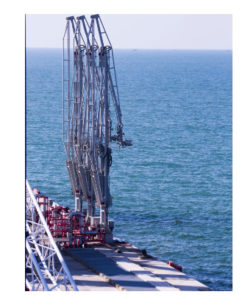A marine loading arm is a flexible, mechanical arm that assists loading or unloading ships. Typically, they transport petroleum and other chemicals between vessels and containers at the docks.
Marine loading arms are an alternative to using direct hookups. Like direct connections, you must completely drain the loading arms before breaking off the links by using high-pressure air to blow out traces or stripping the line using a pump.
Due to what these loading arms carry, they can operate at cryogenic temperatures. Choosing the appropriate seals for this use is essential to ensure the safety of operators and machines alike. Let’s look further into cryogenic seals for marine loading arms.
Why Use Cryogenic Temperatures
Some liquids are too volatile to transport naturally. That is why they are cryogenically cooled into their liquid form. Cooling the air to cryogenic temperatures requires a process of compression, cooling, and expansion.
Moving cryogenic liquids instead of gas is safer and less likely to explode or cause a fire in the event of an accident. However, as these liquids are at sub-zero temperatures, you should use protective equipment when handling them.
There are many types of gasses transported using cryogenic temperatures. The most common use of marine loading arms to load onto ships include liquified petroleum gas, natural gas, liquid oxygen, liquid nitrogen, liquid hydrogen, and liquid helium. The table below shows the temperatures at which these gasses are transported.
| Gas | Temperature °C | Temperature °F |
| Liquified Petroleum Gas | -48°C | -54.4°F |
| Natural Gas | -162°C | -259.6°F |
| Liquid Oxygen | -182°C | -295.6 |
| Liquid Nitrogen | -196°C | -320.8°F |
| Liquid Hydrogen | -253°C | -423.4°F |
| Liquid Helium | -269°C | -452.2°F |
Cryogenic Seal For Marine Loading Arms Design Consideration
The most common cryogenic loading arm seals are a polymer material with a metallic energizer. These materials include
- PTFE
- PCTFE
- TFM
- UHMW PE
PTFE is often the first choice because it is compatible with a wide range of chemicals, has an extremely low coefficient of friction, and is thermally stable. Another valuable material for cryogenic seals is Torlon® Polyamide-imide. Torlon PAI is rigid even at cryogenic temperatures.
These materials have excellent chemical compatibility, low friction, dry-running, and good dimensional stability. Dimensional changes can be accounted for using a spring-energized seal or sizing the seal by accounting for the plastic’s coefficient of thermal expansion.
Cryogenic seals made with PTFE and its variants offer a high strength-to-weight ratio, excellent durability, and self-lubricating properties.
What Cryogenic Seals Materials to Avoid
Traditional compression seals are not a viable choice for cryogenic use. Natural rubber, silicone, Buna-N, fluorocarbon, and ethylene-propylene can handle sub-zero temperatures. However, they cannot correctly seal at cryogenic temperatures. Temperatures below -32°C (-25.6°F) cause the rubber to become brittle.
If you use an inappropriate seal, it will eventually fail. Upon failure, the hazardous liquids flowing through the marine loading arm will escape and can be life-threatening. Some dangers include explosion, fire, asphyxiation, or frostbite.
In addition, there will be dimensional changes between when the seal is installed and when it experiences cryogenic operating conditions. You must ensure that the chosen polymer or elastomer doesn’t become brittle at the cryogenic temperatures involved.
Cryogenic Seal Maintenance Considerations
Periodically, cryogenic seals will require maintenance and replacement. Some things to ensure a longer seal life include understanding conditions, knowing what the seal can withstand, and knowing what to look for when it comes to wearing and lubricating.
Understand Conditions
The conditions in which your marine loading arm works will affect the seals. Temperature, movement, and pressure will eventually cause the seal to wear out and increase leak rates. If you know and understand the exact conditions where the seals will work, you can pick the suitable material for longer-lasting usage.
Knowing What the Seal Can Withstand
All seals have a limit to what they can withstand. Cryogenic seals can withstand temperatures from -269°C (452.2°F) to 148°C (300°F). They typically resist chemicals, natural gas, petroleum, and liquid nitrogen. They can also withstand high-pressure conditions.
Know What to Look for When It Comes to Wear
All seals wear out. Eventually, cryogenic seals are not excluded. Seals begin to wear on the seal face, causing a leak. You should inspect seals regularly for signs of distress, such as chips and grooves. If there are any indications of wear, then you should replace the seal immediately.
Lubricate
The cryogenic fluids themselves usually make for poor lubricators. Any added lubricants or even moisture can freeze onto the face of the seal, causing the seal to shatter or, worse yet, the system to lock up and experience catastrophic damage. However, not using lubrication can result in issues like slip-stick vibration.
Lubricating cryogenic seals is virtually impossible. As a result, using unfilled polymer materials or a modified material may be the only option.
Best Cryogenic Seals for Marine Loading Arms
Choosing the best cryogenic seals for marine loading arms will depend on what you are transporting. Most cryogenic seals will work in marine loading arms, but some materials work better than others. The most common materials are PTFE, PCTFE, TFM, and UHMW PE.
Advanced EMC offers a wide array of cryogenic seals. If you are interested in purchasing cryogenic seals, contact us today!
FAQ
How do you seal liquid nitrogen?
Sealing liquid nitrogen requires either silicone or PTFE seals. If the seal comes into contact with the liquid nitrogen, PTFE seals are the better choice as this material can handle cold flow without causing creep.
What is the purpose of marine loading arms?
Marine loading arms load or unload vessels carrying petroleum products. They are made of several sections of pipes connected by quick-connect fittings and swivel joints. Cryogenic seals are used between the fittings and joints when transporting liquid nitrogen, liquid petroleum, or any other liquid stored at cryogenic temperatures.

